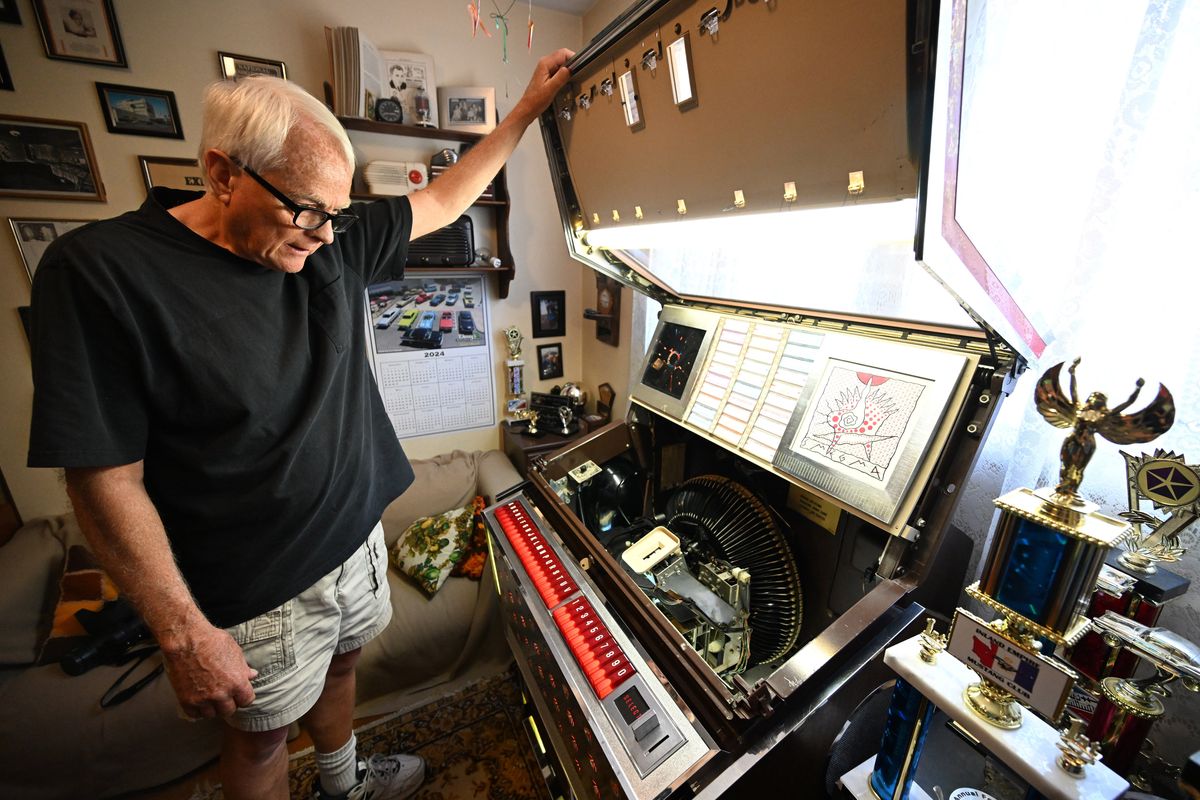The Collector: Dean Carriveau has brought jukeboxes and pinball machines back to life

Back in the day, when people still had change in their pockets, lots of fun could be had for a nickel, dime or quarter.
At Dean Carriveau’s South Hill home, that fun is still available.
Carriveau collects and restores vintage jukeboxes and pinball machines.
His affinity for all things electromechanical began as a young teen when he built a solid-state radio.
“I got the bug,” he said.
For 29 years, he worked as a technician for AT&T. When he retired, he said, “I needed something to do.”
He returned to school and became a teacher, but in the meantime, a fortuitous auction launched his collection.
“In 1985, Follet Music Co. closed its doors after many years of providing jukeboxes, pinball, cigarette and gum machines in the Spokane area,” Carriveau said.
He attended the auction and hauled home a treasure trove of jukeboxes and pinball machines – most in dire need of repair.
The fun began as he painstakingly replaced parts and refurbished the items to their former glory.
“It takes a year or more to restore a machine – some have gathered dust for years, patiently waiting for me to get to them.”
In a darkened room, a ROWE AMI jukebox glows. A selection of 45s, ranging from Aretha Franklin’s “The Thrill is Gone” to Air Supply’s “All Out of Love,” is available with the push of the chunky red buttons.
Downstairs, a 1949 Seeburg with its accompanying wall box is of special note.
“It changed the game for everything,” Carriveau said. “It plays both sides of 50 records – 100 songs!”
The clear glass top allows you to watch the records slide and drop into place, after inserting a coin.
“They’re called visible machines,” he said. “A guy in Medical Lake had it, and it was in pretty bad shape.”
The wall boxes sat on tabletops or were mounted nearby, so diner or bar patrons could choose their musical selections without going to the machine.
Nearby, a 1963 Seeburg plays 45s and 33⅓s for 10 cents a pop. The script above promises “The finest stereo LP albums of the month.”
Each era featured a different style from Art Deco to the automotive-inspired jukeboxes of the late 1950s.
For example, a 1959, AMI Model J-200 50th Anniversary Edition sports chrome trim and a windshield-like top.
“This is the first high-fidelity stereo jukebox,” Carriveau said. “I loved the look of it.”
The machine sat in his basement for 30 years before he got around to restoring it.
“It’s my favorite because it was a huge challenge. I found parts online from all over the world – Italy, Germany, Brazil. It’s a beautiful piece of engineering.”
He inserted a nickel and the dulcet voice of Crystal Gayle singing “Cry Me a River” filled the room.
At a garage sale near Manito Park, Carriveau discovered a beautiful 1950 red and gold Wurlitzer.
“It was the first machine to play both sides of the 78s,” he said.
One of the most striking machines in his collection is a 1946 Seeburg Symphonola aka “The Trashcan.”
The large wooden cabinet topped with a lighted dome and trimmed with lighted panels weighs 350 pounds.
Then there are his pinball machines with insides that look similar to the equipment he used to repair at AT&T – flat spring relays, motors, contacts and color-coded wiring.
“Dreamy,” a 1950 Williams pinball game, features a wood cabinet, the legs and the face of a red-haired beauty, and has a musical theme.
A 1963 “Major League” game includes miniature baseball players that move according to how skilled the pinball player is.
“This is a lot of fun to play,” said Carriveau, tapping the top of his 1957 wood-railed ‘Flagship’ game. “It makes a lot of noise.”
His wife Jan prefers the “Disco A-Go-Go” game. She paid $10 for it at the Follet auction.
The minimalist, angular images on the machine are often referred to as “Pointy People,” and were developed by pinball artist Jerry Kelley.
In addition to jukeboxes and pinball, Carriveau has other coin-operated bits of nostalgia. A gum machine that offers packs of Clove and Blackjack gum, a 1930s-era pay phone that he used for testing at AT&T, and a cigarette machine from the 1940s he discovered at Goodwill.
He even found a metal cologne dispenser from the old Capitol Bar in Hillyard. For a quarter, fellows could get a spritz of Brut, Old Spice or Jade East.
His wife convinced him to refurbish an old one-armed bandit slot machine she found at a shop in Hillyard.
“Nothing worked,” Carriveau said. “But I got it to jackpot. It takes dimes and the big payout is $5.”
His coin-operated collection is a combination of art, music, history and entertainment.
“It’s just something that fell into my lap,” he said.
“The best part is watching other people enjoy it.”